Spectral and Soil Quality Index for Monitoring Environmental Rehabilitation and Soil Carbon Stock in an Amazonian Sandstone Mine
Abstract
1. Introduction
2. Materials and Methods
2.1. Study Site
2.2. Soil Sampling and Analyses
2.2.1. Physical and Chemical Analyses
2.2.2. Biological and Biochemical Analyses
2.3. Remote Sensing Tools
2.4. Soil Quality Index
2.5. Statistical Analyses
3. Results
3.1. Calculated and Predicted SOC Stock
3.2. Soil Quality Index
3.3. Relationship between Indices and Soil Attributes
4. Discussion
4.1. SOC Stock and Rehabilitation
4.2. Prediction of SOC Stock by Spectral Indices
4.3. Correlation of Indices and Soil Attributes
4.4. Importance of SOC Stock
5. Conclusions
Supplementary Materials
Author Contributions
Funding
Data Availability Statement
Acknowledgments
Conflicts of Interest
References
- Gastauer, M.; Souza Filho, P.W.M.; Ramos, S.J.; Caldeira, C.F.; Silva, J.R.; Siqueira, J.O.; Furtini Neto, A.E. Mine land rehabilitation in Brazil: Goals and techniques in the context of legal requirements. Ambio 2019, 48, 74–88. [Google Scholar] [CrossRef]
- Buta, M.; Blaga, G.; Paulette, L.; Păcurar, I.; Roşca, S.; Borsai, O.; Grecu, F.; Sînziana, P.E.; Negruşier, C. Soil reclamation of abandoned mine lands by revegetation in Northwestern part of Transylvania: A 40-Year retrospective study. Sustainability 2019, 11, 3393. [Google Scholar] [CrossRef]
- Marques, M.; Aguiar, C.R.C.; Soares da Silva, J.J.L. Desafios técnicos e barreiras sociais, econômicas e regulatórias na fitorremediação de solos contaminados. Rev. Bras. Cienc. Solo 2011, 35, 1. [Google Scholar] [CrossRef]
- Ranjan, V.; Sen, P.; Kumar, D.; Sarsawat, A. A review on dump slope stabilization by revegetation with reference to indigenous plant. Ecol. Processes 2015, 4, 14. [Google Scholar] [CrossRef]
- Silva, J.R.; Gastauer, M.; Ramos, S.J.; Mitre, S.K.; Furtini Neto, A.E.; Siqueira, J.O.; Caldeira, C.F. Initial growth of Fabaceae species: Combined effects of topsoil and fertilizer application for mineland revegetation. Flora 2018, 246–247, 109–117. [Google Scholar] [CrossRef]
- Feng, Y.; Wang, J.; Bai, Z.; Reading, L. Effects of surface coal mining and land reclamation on soil properties: A review. Earth-Sci. Rev. 2019, 191, 12–25. [Google Scholar] [CrossRef]
- Suleymanov, A.; Abakumov, E.; Suleymanov, R.; Gabbasova, I.; Komissarov, M. The soil nutrient digital mapping for precision agriculture cases in the trans-ural steppe zone of Russia using topographic attributes. ISPRS 2021, 10, 243. [Google Scholar] [CrossRef]
- Angelopoulou, T.; Tziolas, N.; Balafoutis, A.; Zalidis, G.; Bochtis, D. Remote sensing techniques for soil organic carbon estimation: A review. Remote Sens. 2019, 11, 676. [Google Scholar] [CrossRef]
- Alves, R.P.; Couto Junior, A.F.; Martins, E.d.S.; Nardoto, G.B. Role of soil carbon in the landscape functioning of the Alto São Bartolomeu watershed in the Cerrado region, Brazil. Pesqui. Agropecu. Bras. 2016, 51, 1241–1251. [Google Scholar] [CrossRef][Green Version]
- Kumar, P.; Pandey, P.C.; Singh, B.K.; Katiyar, S.; Mandal, V.; Rani, M.; Tomar, V.; Patairiya, S. Estimation of accumulated soil organic carbon stock in tropical forest using geospatial strategy. Egypt. J. Remote Sens. Space Sci. 2016, 19, 109–123. [Google Scholar] [CrossRef]
- Zhang, Y.; Guo, L.; Chen, Y.; Shi, T.; Luo, M.; Ju, Q.; Zhang, H.; Wang, S. Prediction of soil organic carbon based on landsat 8 monthly ndvi data for the jianghan plain in Hubei Province, China. Remote Sens. 2019, 11, 1683. [Google Scholar] [CrossRef]
- Abdel Rahman, M.A.E.; Shalaby, A.; Mohamed, E.S. Comparison of two soil quality indices using two methods based on geographic information system. Egypt. J. Remote Sens. Space Sci. 2019, 22, 127–136. [Google Scholar] [CrossRef]
- Mukhopadhyay, S.; Maiti, S.K.; Masto, R.E. Development of mine soil quality index (MSQI) for evaluation of reclamation success: A chronosequence study. Ecol. Eng. 2014, 71, 10–20. [Google Scholar] [CrossRef]
- Bastida, F.; Zsolnay, A.; Hernández, T.; García, C. Past, present and future of soil quality indices: A biological perspective. Geoderma 2008, 147, 159–171. [Google Scholar] [CrossRef]
- Doran, J.W.; Parkin, T.B. Defining and Assessing Soil Quality. Chapters 1–8, pp. 1–21. In Defining Soil Quality for a Sustainable Environment; Doran, J.W., Coleman, D.C., Bezdicek, D.F., Stewart, B.A., Eds.; SSSA Special Publication, Inc.: Madison, WI, USA, 1994; Volume 35, p. 244. [Google Scholar]
- Cherubin, M.R.; Karlen, D.L.; Cerri, C.E.P.; Franco, A.L.C.; Tormena, C.A.; Davies, C.A.; Cerri, C.C. Soil quality indexing strategies for evaluating sugarcane expansion in Brazil. PLoS ONE 2016, 11, 0150860. [Google Scholar] [CrossRef] [PubMed]
- McBratney, A.B.; Stockmann, U.; Angers, D.A.; Minasny, B.; Field, D.J. Challenges for Soil Organic Carbon Research. In Soil Carbon. Progress in Soil Science; Hartemink, A., McSweeney, K., Eds.; Springer: Cham, Switzerland, 2014. [Google Scholar]
- Lorenz, K.; Lal, R.; Ehlers, K. Soil organic carbon stock as an indicator for monitoring land and soil degradation in relation to United Nations’ Sustainable Development Goals. Land Degrad. Dev. 2019, 30, 824–838. [Google Scholar] [CrossRef]
- Alvares, C.A.; Stape, J.L.; Sentelhas, P.C.; De Moraes Gonçalves, J.L.; Sparovek, G. Köppen’s climate classification map for Brazil. Meteorol. Zeitschrift. 2013, 22, 711–728. [Google Scholar] [CrossRef]
- Ribeiro, R.A.; Giannini, T.C.; Gastauer, M.; Awade, M.; Siqueira, J.O. Topsoil application during the rehabilitation of a manganese tailing dam increases plant taxonomic, phylogenetic and functional diversity. J. Environ. Manag. 2018, 227, 386–394. [Google Scholar] [CrossRef]
- Gastauer, M.; Caldeira, C.F.; Ramos, S.J.; Silva, D.F.; Siqueira, J.O. Active rehabilitation of Amazonian sand mines converges soils, plant communities and environmental status to their predisturbance levels. Land Degrad. Dev. 2019, 31, 607–618. [Google Scholar] [CrossRef]
- Trindade, F.C.; Gastauer, M.; Ramos, S.J.; Caldeira, C.F.; Araújo, J.F.d.; Oliveira, G.; Valadares, R.B.d.S. Soil Metaproteomics as a Tool for Environmental Monitoring of Minelands. Forests 2021, 12, 1158. [Google Scholar] [CrossRef]
- Teixeira, P.C.; Donagemma, G.K.; Fontana, A.; Teixeira, W.G. Manual de Métodos de Análise de Solo, 3rd ed.; Revista e Ampliada Publisher: Embrapa Brasília, Brazil, 2017. [Google Scholar]
- Bouyoucos, G.J. The hydrometer as a new method for the mechanical analysis of soils. Soil Sci. 1927, 23, 343–354. [Google Scholar] [CrossRef]
- Benites, V.M.; Machado, P.L.O.A.; Fidalgo, E.C.C.; Coelho, M.R.; Madari, B.E. Pedotransfer functions for estimating soil bulk density from existing soil survey reports in Brazil. Geoderma 2007, 139, 90–97. [Google Scholar] [CrossRef]
- Briedis, C.; Sá, J.C.d.M.; De-Carli, R.S.; Antunes, E.A.P.; Simon, L.; Romko, M.L.; Elias, L.S.; Ferreira, A.d.O. Particulate soil organic carbon and stratification ratio increases in response to crop residue decomposition under no-till. Rev. Bras. Cienc. Solo 2012, 36, 1483–1490. [Google Scholar] [CrossRef]
- Vance, E.D.; Brookes, P.C.; Jenkinson, D.S. An extraction method for measuring soil microbial biomass C. Soil Biol. Biochem. 1987, 19, 703–707. [Google Scholar] [CrossRef]
- Jenkinson, D.S.; Powlson, D.S. The effects of biocidal treatments on metabolism in soil—V. Soil Biol. Biochem. 1976, 8, 209–213. [Google Scholar] [CrossRef]
- Anderson, T.H.; Domsch, K.H. The metabolic quotient for CO2 (qCO2) as a specific parameter to assess the effects of environmental conditions, such as pH, on the microbial biomass of forest soils. Soil Biol. Biochem. 1993, 25, 393–395. [Google Scholar] [CrossRef]
- Sparling, G.P. Ratio of microbial biomass carbon to soil organic carbon as a sensitive indicator of changes in soil organic matter. Aust. J. Soil Res. 1992, 30, 195–207. [Google Scholar] [CrossRef]
- Tabatabai, M.A.; Bremner, J.M. Assay of urease activity in soil. Soil Biol. Biochem. 1971, 4, 479–487. [Google Scholar] [CrossRef]
- Dick, R.P.; Breakwell, D.P.; Turco, R.F. Soil Enzyme Activities and Biodiversity Measurements as Integrative Microbiological Indicators. In Methods for Assessing Soil Quality, 1st ed.; Doran, J.W., Jones, A.J., Eds.; Soil Science Society of America: Madison, WI, USA, 1997; Volume 49, pp. 247–271. [Google Scholar]
- Rodríguez-Rodríguez, R.M.; Kemmelmeier, K.; Pedroso, D.d.F.; Pinto, F.A.; dos Santos, J.V.; Gastauer, M.; Caldeira, C.F.; Ramos, S.J.; Siqueira, J.O.; Carneiro, M.A.C. Native arbuscular mycorrhizal fungi respond to rehabilitation in iron ore mining areas from the Eastern Brazilian Amazon. Pedobiologia 2021, 89, 150768. [Google Scholar] [CrossRef]
- Rouse, J.W.; Haas, R.H.; Schell, J.A.; Deering, D.W. Monitoring Vegetation Systems in the Great Plains with ERTS. In Proceedings of the Third ERTS Symposium, Washington, DC, USA, 10–14 December 1973; Freden, S.C., Mercanti, E.P., Becker, M.A., Eds.; NASA: Washington, DC, USA, 1974. [Google Scholar]
- Jamalabad, M.S.; Abkar, A.A. Forest Canopy Density Monitoring, Using Satellite Images. In Proceedings of the 20th ISPRS Congress. International Society for Photogrammetry and Remote Sensing, Istanbul, Turkey, 12–23 July 2004; pp. 12–23. [Google Scholar]
- QGIS Development Team. QGIS Geographic Information System (Version 3.10). Open Source Geospatial Foundation Project. 2021. Available online: http://qgis.osgeo.org (accessed on 28 November 2020).
- R Development Core Team. R: A Language and Environment for Statistical Computing; (Version 3.6.2); R Foundation for Statistical Computing: Vienna, Austria, 2021; Available online: https://www.r-project.org/ (accessed on 28 November 2020).
- Freitas, D.A.F.; Silva, M.L.N.; Cardoso, E.L.; Curi, N. Índices de qualidade do solo sob diferentes sistemas de uso e manejo florestal e cerrado nativo adjacente. Rev. Ciênc. Agron. 2012, 43, 417–428. [Google Scholar] [CrossRef]
- Zuur, A.F.; Ieno, E.N.; Elphick, C.S. A protocol for data exploration to avoid common statistical problems. Methods Ecol. Evol. 2010, 1, 3–14. [Google Scholar] [CrossRef]
- Ferreira, E.B.; Cavalcanti, P.P.; Nogueira, D.A. ExpDes.pt: Pacote Experimental Designs (Portugues) 2021. R Package Version 1.2.1. Available online: https://CRAN.R-project.org/package=ExpDes.pt (accessed on 28 November 2020).
- Wickham, H. ggplot2—Elegant Graphics for Data Analysis, 2nd ed.; Springer International Publishing: Cham, Switzerland, 2016; p. 260. Available online: https://ggplot2.tidyverse.org (accessed on 28 November 2020).
- Harrell, F.E., Jr. With Contributions from Charles Dupont. Hmisc: Harrell Miscellaneous. 2021. R Package Version 4.5-0. Available online: https://CRAN.R-project.org/package=Hmisc (accessed on 28 November 2020).
- Wei, T.; Simko, V. R Package ‘Corrplot’: Visualization of a Correlation Matrix (Version 0.90). 2021. Available online: https://github.com/taiyun/corrplot (accessed on 28 November 2020).
- Wang, W.; Zhong, Z.; Wang, Q.; Wang, H.; Fu, Y.; He, X. Glomalin contributed more to carbon, nutrients in deeper soils, and differently associated with climates and soil properties in vertical profiles. Sci. Rep. 2017, 7, 13003. [Google Scholar] [CrossRef] [PubMed]
- Wright, S.F.; Upadhyaya, A.A. Survey of soils for aggregate stability and glomalin, a glycoprotein produced by hyphae of arbuscular mycorrhizal fungi. Plant Soil 1998, 198, 97–107. [Google Scholar] [CrossRef]
- Zipper, C.; Burger, J.; Barton, C.; Skousen, J. Rebuilding soils for forest restoration on Appalachian mined lands. Soil Sci. Soc. Am. J. 2013, 77, 337–349. [Google Scholar] [CrossRef]
- Wang, Z.; Wang, G.; Ren, T.; Wang, H.; Xu, Q.; Zhang, G. Assessment of soil fertility degradation affected by mining disturbance and land use in a coalfield via machine learning. Ecol. Indic. 2021, 125, 107608. [Google Scholar] [CrossRef]
- Madasa, A.; Orimoloye, I.R.; Ololade, O.O. Application of Geospatial Indices for Mapping Land Cover/Use Change Detection in a Mining Area. J. Afr. Earth Sci. 2021, 175, 104108. [Google Scholar] [CrossRef]
- Padilha, M.C.D.C.; Vicente, L.E.; Demattê, J.A.; Loebmann, D.G.D.S.W.; Vicente, A.K.; Salazar, D.F.; Guimarães, C.C.B. Using Landsat and soil clay content to map soil organic carbon of oxisols and Ultisols near São Paulo, Brazil. Geoderma Reg. 2020, 21, e00253. [Google Scholar] [CrossRef]
- Xue, J.R.; Su, B.F. Significant remote sensing vegetation indices: A review of developments and applications. J. Sens. 2017, 2017, 2101353691. [Google Scholar] [CrossRef]
- Diek, S.; Fornallaz, F.; Schaepman, M.E.; De Jong, R. Barest pixel composite for agricultural areas using landsat time series. Remote Sens. 2017, 9, 1245. [Google Scholar] [CrossRef]
- Paz-Kagan, T.; Shacha, M.; Zaady, E.; Karnieli, A. A spectral soil quality index (SSQI) for characterizing soil function in areas of changed land use. Geoderma 2014, 230, 171–184. [Google Scholar] [CrossRef]
- Franzluebbers, A.J. Soil organic matter stratification ratio as an indicator of soil quality. Soil Tillage Res. 2002, 66, 95–106. [Google Scholar] [CrossRef]
- Zuber, S.M.; Behnke, G.D.; Nafziger, E.D.; Villamil, M.B. Multivariate assessment of soil quality indicators for crop rotation and tillage in Illinois. Soil Tillage Res. 2016, 174, 147–155. [Google Scholar] [CrossRef]
- Guo, S.; Han, X.; Li, H.; Wang, T.; Tong, X.; Ren, G.; Feng, Y.; Yang, G. Evaluation of soil quality along two revegetation chronosequences on the Loess Hilly Region of China. Sci. Total. Environ. 2018, 633, 808–815. [Google Scholar] [CrossRef]
- Paul, G.C.; Saha, S.; Ghosh, K.G. Assessing the soil quality of Bansloi river basin, eastern India using soil-quality indices (SQIs) and random forest machine learning technique. Ecol. Indic. 2020, 118, 106804. [Google Scholar] [CrossRef]
- Srivastava, P.; Singh, R.; Bhadouria, R.; Tripathi, S.; Raghubanshi, A.S. Temporal change in soil physicochemical, microbial, aggregate and available C characteristic in dry tropical ecosystem. Catena 2020, 190, 104553. [Google Scholar] [CrossRef]
- Anderson, T.H. Physiological Analysis of Microbial Communities in Soil: Applications and limitations. In Beyond the Biomass—Compositional and Functional Analysis of Soil Microbial Communities; Rittz, K., Dighton, J., Giller, K.E., Eds.; John Wiley & Sons: Chichester, UK, 1994; pp. 67–76. [Google Scholar]
- Jacinthe, P.A.; Lal, R. Carbon storage and minesoil properties in relation to topsoil application techniques. Soil Sci. Soc. Am. J. 2007, 71, 1788–1795. [Google Scholar] [CrossRef]
- Lewis, T.; Verstraten, L.; Hogg, B.; Wehr, B.J.; Swift, S.; Tindale, N.; Menzies, N.W.; Dalal, R.C.; Bryant, P.; Francis, B.; et al. Reforestation of agricultural land in the tropics: The relative contribution of soil, living biomass and debris pools to carbon sequestration. Sci. Total Environ. 2019, 649, 1502–1513. [Google Scholar] [CrossRef] [PubMed]
- Wang, Y.; Weng, B.; Tian, N.; Zhong, Z.; Wang, M. Soil organic carbon stocks of citrus orchards in Yongchun county, Fujian province, China. Pedosphere 2017, 27, 985–990. [Google Scholar] [CrossRef]
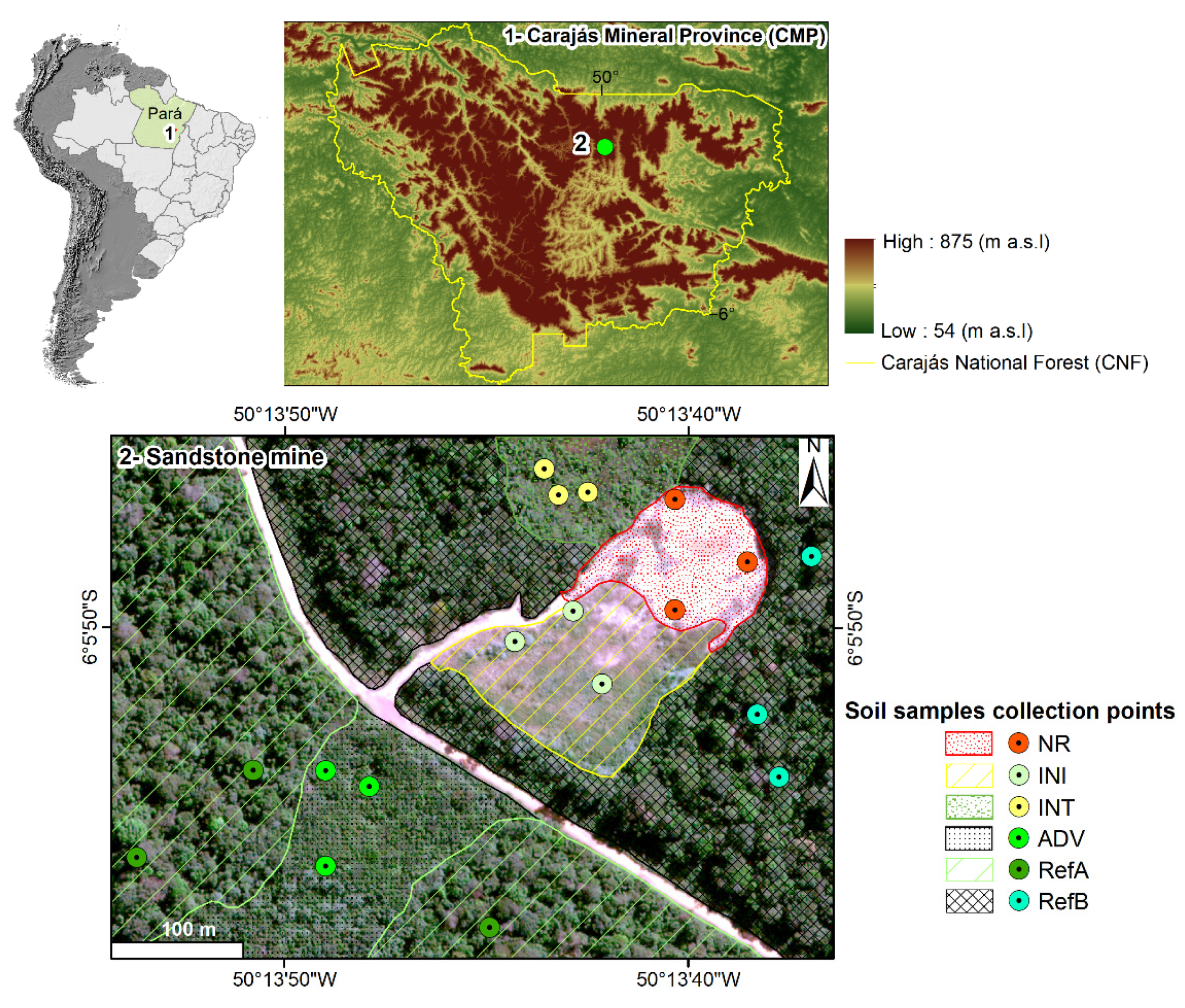
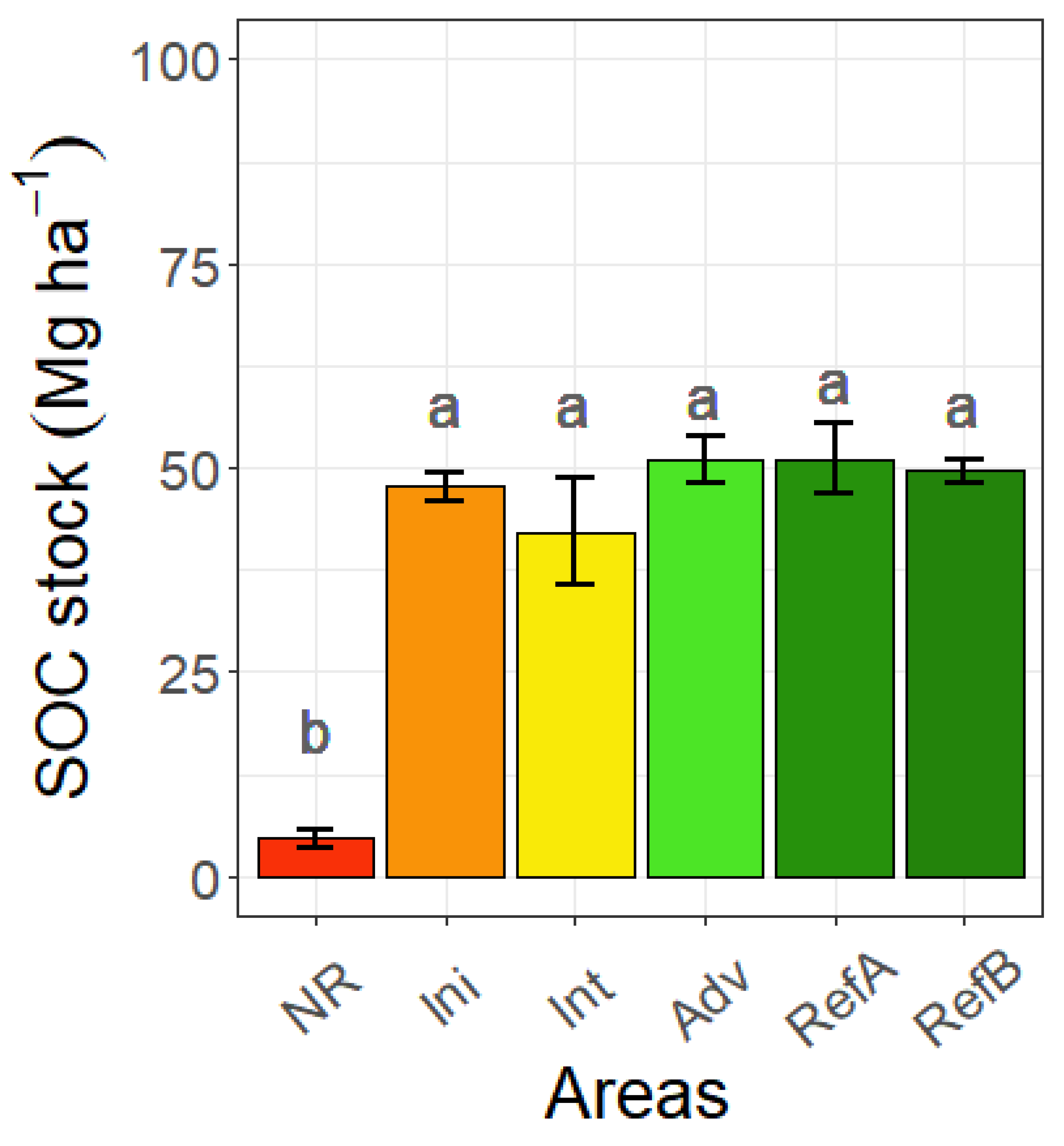
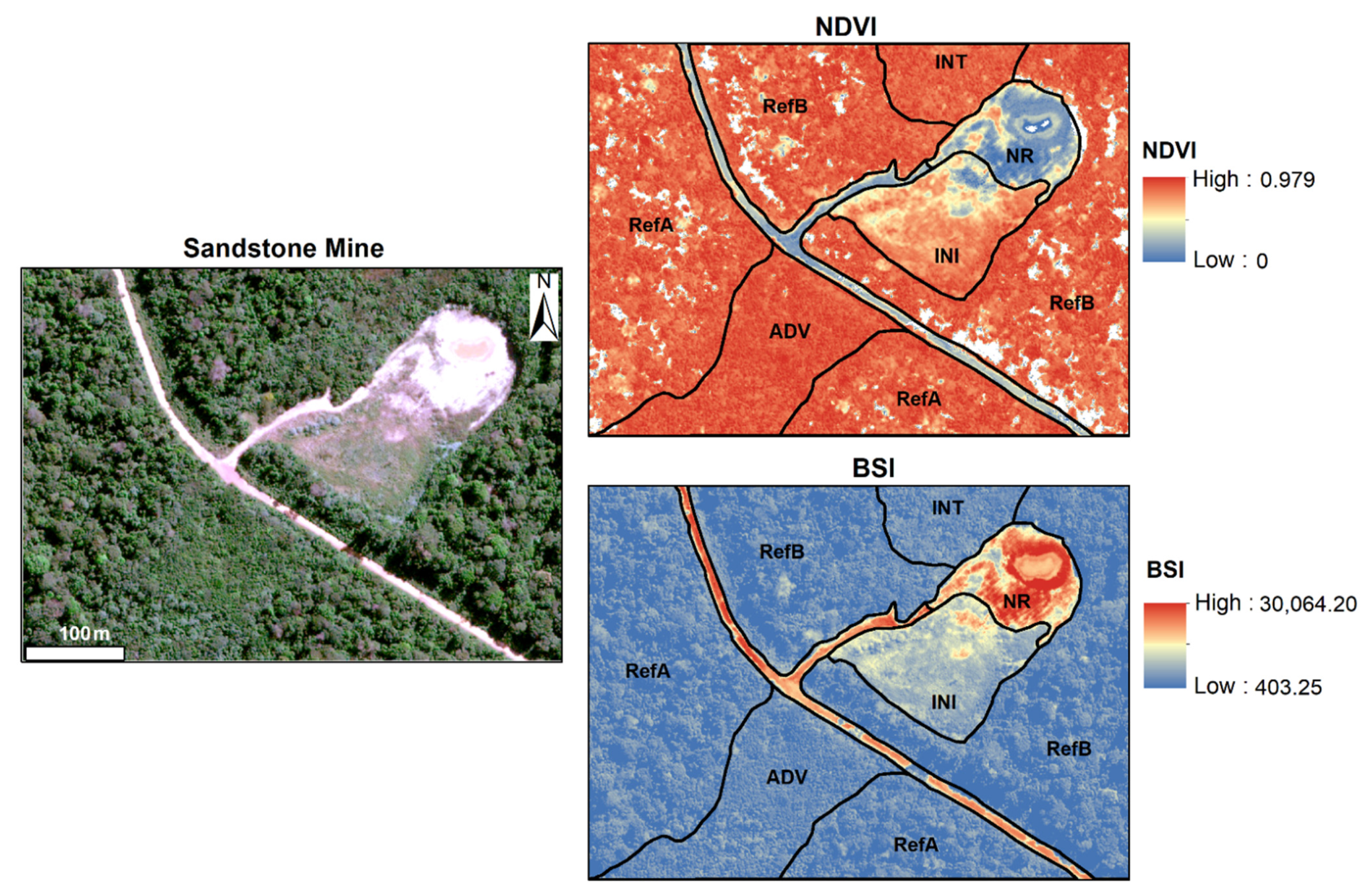

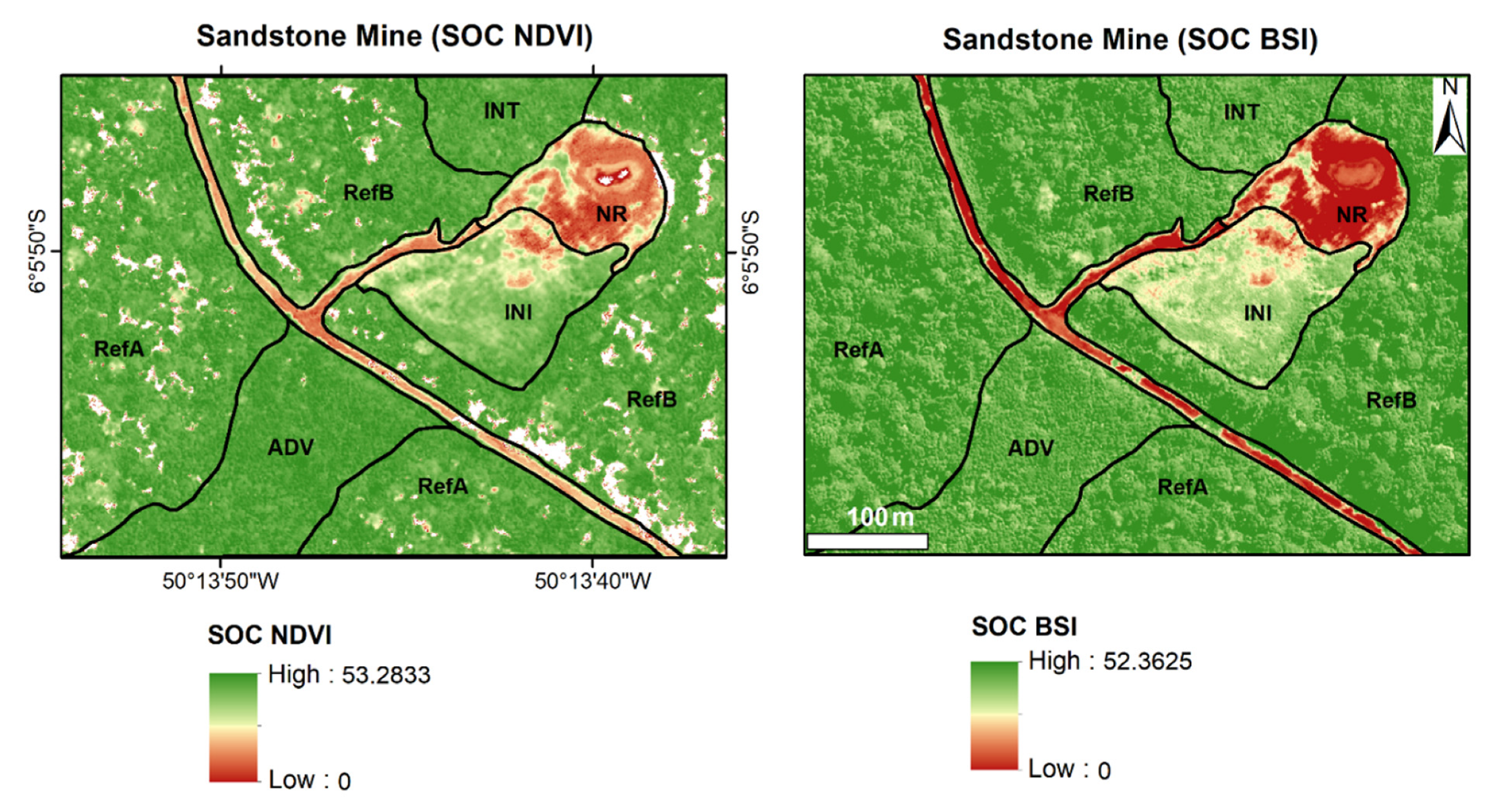
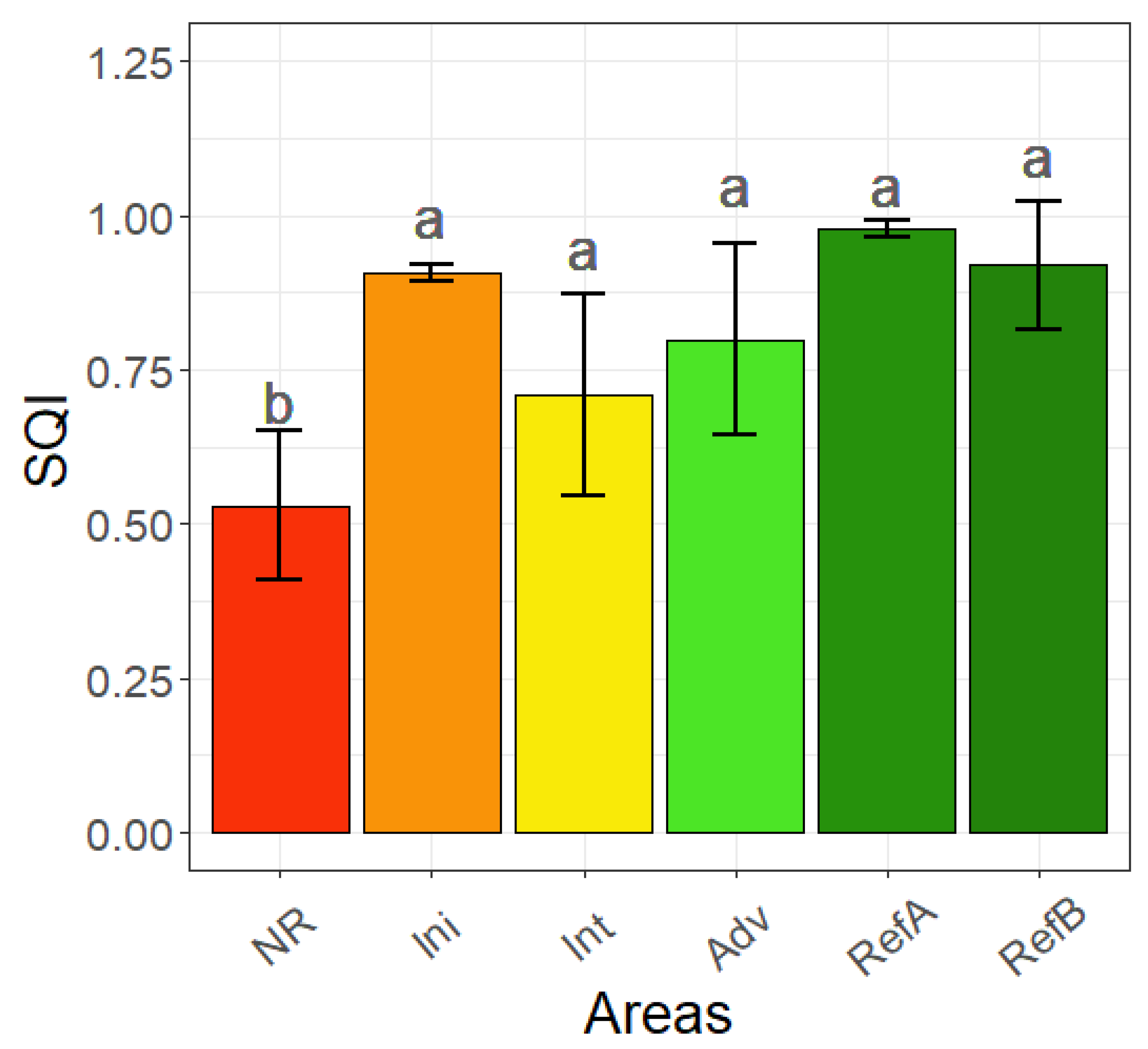
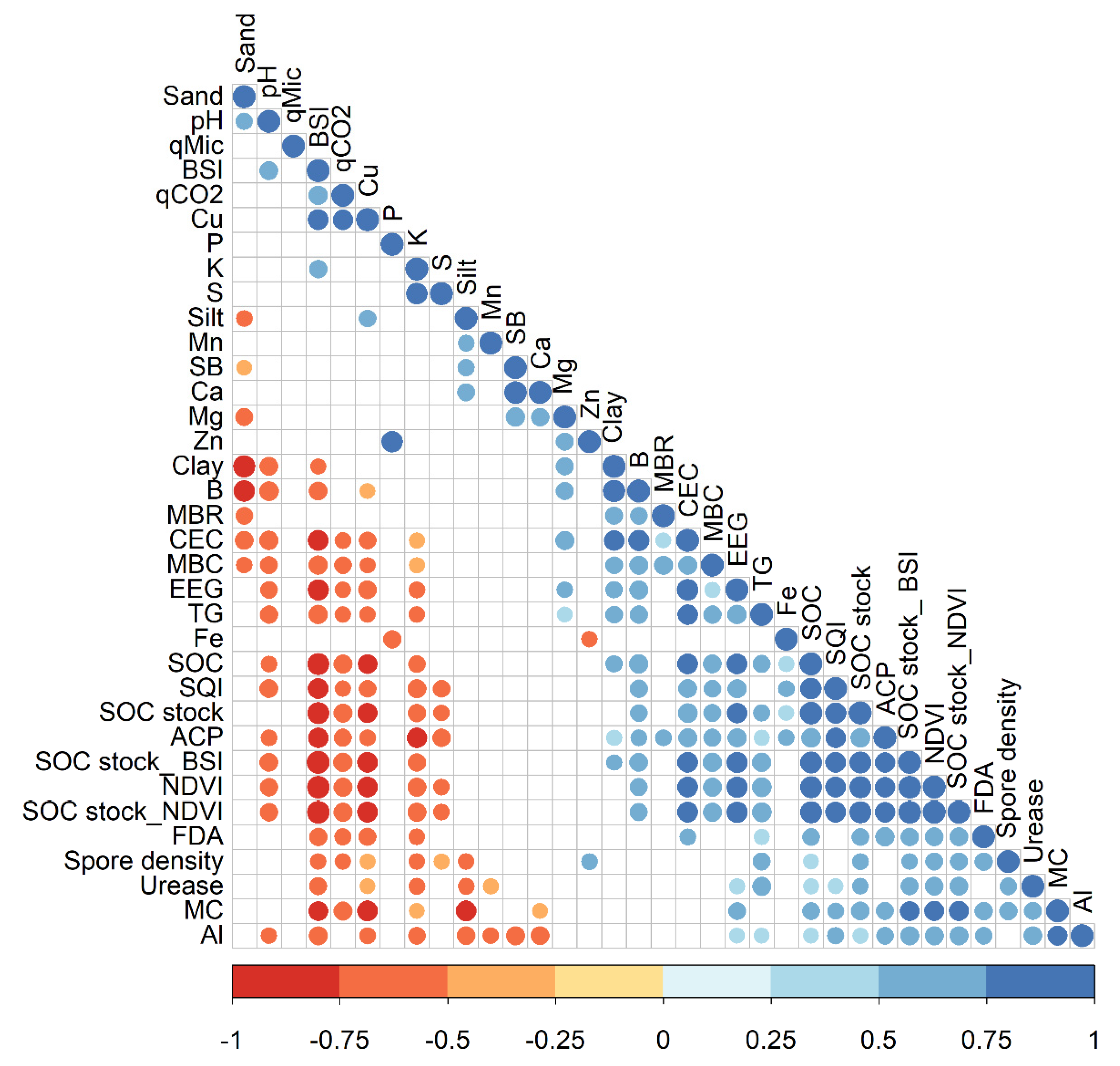
| Variables | PC1 | PC2 | PC3 | PC4 | PC5 |
|---|---|---|---|---|---|
| Eigenvalue | 12.3874 | 5.7197 | 3.6694 | 2.0894 | 1.94200 |
| Proportion Explained | 0.3996 | 0.1845 | 0.1184 | 0.0674 | 0.06265 |
| Cumulative Proportion | 0.3996 | 0.5841 | 0.7025 | 0.7699 | 0.83251 |
| MBC | −0.65313 | −0.16213 | −0.157017 | 0.22987 | −0.111846 |
| MBR | −0.43884 | −0.19344 | −0.427953 | 0.29269 | −0.091320 |
| qCO2 | 0.62793 | −0.12045 | −0.078734 | 0.16065 | 0.036212 |
| FDA | −0.60559 | 0.17646 | 0.088920 | −0.14935 | −0.106586 |
| ACP | −0.72054 | 0.06431 | −0.131962 | −0.02218 | −0.304460 |
| Urease | −0.51421 | 0.40184 | 0.115149 | 0.27674 | 0.113851 |
| SOC | −0.79587 | −0.06548 | −0.005126 | −0.22220 | −0.024674 |
| qMic | 0.20860 | −0.01069 | −0.201264 | 0.41911 | −0.285524 |
| EEG | −0.73553 | −0.10646 | 0.143522 | −0.02604 | 0.143804 |
| TG | −0.67227 | −0.08670 | 0.256033 | 0.34812 | 0.087060 |
| MC | −0.60902 | 0.47916 | 0.111600 | −0.10043 | 0.179749 |
| Spore density | −0.48288 | 0.34169 | 0.456930 | −0.02978 | −0.124345 |
| pH | 0.58855 | 0.17741 | 0.112644 | −0.30481 | −0.210531 |
| SOM | −0.79587 | −0.06548 | −0.005126 | −0.22220 | −0.024674 |
| P | 0.16489 | −0.06453 | 0.759765 | 0.11801 | −0.186024 |
| K | 0.58224 | −0.23642 | −0.031998 | −0.19649 | 0.484994 |
| S | 0.41775 | −0.23191 | −0.111371 | −0.06735 | 0.631474 |
| Ca | 0.04983 | −0.73991 | 0.281827 | 0.01261 | −0.006268 |
| Mg | −0.36948 | −0.58008 | 0.411408 | −0.03853 | 0.087366 |
| Al | −0.57051 | 0.50968 | −0.192642 | 0.16558 | 0.118559 |
| CEC | −0.75745 | −0.33479 | 0.099478 | 0.05925 | 0.068868 |
| B | −0.64641 | −0.48318 | −0.208323 | 0.06979 | 0.115216 |
| Zn | −0.12725 | −0.12226 | 0.779826 | 0.03169 | −0.110145 |
| Fe | −0.36949 | −0.03414 | −0.567148 | −0.36857 | −0.168348 |
| Mn | 0.11565 | −0.39534 | −0.033075 | −0.60873 | −0.290828 |
| Cu | 0.66819 | −0.16544 | −0.056341 | 0.28560 | −0.308134 |
| Clay | −0.55831 | −0.51766 | −0.216429 | 0.09687 | 0.145571 |
| Silt | 0.27642 | −0.67899 | −0.191794 | 0.06242 | −0.366750 |
| Sand | 0.39844 | 0.66742 | 0.249704 | −0.10430 | −0.009997 |
| SB | 0.06702 | −0.75870 | 0.303340 | −0.02623 | 0.084294 |
| SOC stock | −0.77139 | 0.04827 | 0.047942 | −0.27408 | −0.067842 |
Publisher’s Note: MDPI stays neutral with regard to jurisdictional claims in published maps and institutional affiliations. |
© 2022 by the authors. Licensee MDPI, Basel, Switzerland. This article is an open access article distributed under the terms and conditions of the Creative Commons Attribution (CC BY) license (https://creativecommons.org/licenses/by/4.0/).
Share and Cite
Ribeiro, P.G.; Martins, G.C.; Gastauer, M.; da Silva Junior, E.C.; Santos, D.C.; Frois Caldeira Júnior, C.; Cavalcante, R.B.L.; dos Santos, D.S.; Carneiro, M.A.C.; Valadares, R.B.d.S.; et al. Spectral and Soil Quality Index for Monitoring Environmental Rehabilitation and Soil Carbon Stock in an Amazonian Sandstone Mine. Sustainability 2022, 14, 597. https://doi.org/10.3390/su14020597
Ribeiro PG, Martins GC, Gastauer M, da Silva Junior EC, Santos DC, Frois Caldeira Júnior C, Cavalcante RBL, dos Santos DS, Carneiro MAC, Valadares RBdS, et al. Spectral and Soil Quality Index for Monitoring Environmental Rehabilitation and Soil Carbon Stock in an Amazonian Sandstone Mine. Sustainability. 2022; 14(2):597. https://doi.org/10.3390/su14020597
Chicago/Turabian StyleRibeiro, Paula Godinho, Gabriel Caixeta Martins, Markus Gastauer, Ediu Carlos da Silva Junior, Diogo Corrêa Santos, Cecílio Frois Caldeira Júnior, Rosane Barbosa Lopes Cavalcante, Douglas Silva dos Santos, Marco Aurélio Carbone Carneiro, Rafael Borges da Silva Valadares, and et al. 2022. "Spectral and Soil Quality Index for Monitoring Environmental Rehabilitation and Soil Carbon Stock in an Amazonian Sandstone Mine" Sustainability 14, no. 2: 597. https://doi.org/10.3390/su14020597
APA StyleRibeiro, P. G., Martins, G. C., Gastauer, M., da Silva Junior, E. C., Santos, D. C., Frois Caldeira Júnior, C., Cavalcante, R. B. L., dos Santos, D. S., Carneiro, M. A. C., Valadares, R. B. d. S., Nascimento Junior, W. d. R., Oliveira, G., Souza Filho, P. W. M. e., & Ramos, S. J. (2022). Spectral and Soil Quality Index for Monitoring Environmental Rehabilitation and Soil Carbon Stock in an Amazonian Sandstone Mine. Sustainability, 14(2), 597. https://doi.org/10.3390/su14020597









